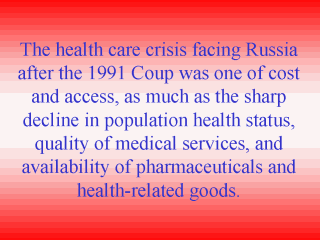 |
Feshbach and
Friendly (1992) state that the health plans and policy revisions enacted during
Perestroika had little beneficial effect on the demographic and health trends from
previous Soviet administrations. Russian physicians intensified a rolling strike in May
1992, protesting continued low wages, scarce supplies, and insufficient allocation of GNP
resources to health care. In 1990 3.6 percent of the GNP in the FSU was allocated to
health care, compared to lo.6 percent of the GNP in the U-S- in 1988, 12.4 percent in
1992, and an estimated 21 percent of the U.S. GNP by the end of the decade (Davis 1992).
The life expectancy of Moscow residents in 1990 was ten years shorter than it had been in
1970. In 1989, the infant mortality rate was 22. 3 infant deaths per thousand live births,
compared with lo. I for the U.S.; life expectancy for the soviet Union was 69.8 years,
compared with 75 years for the U.S. in 1987 (Rowland and Telyukov 1991; Mezentseva and
Rimachevskaya 1990). The reformers of the Russian Federation set out to chart the
direction of economic change by enacting health legislation. |
